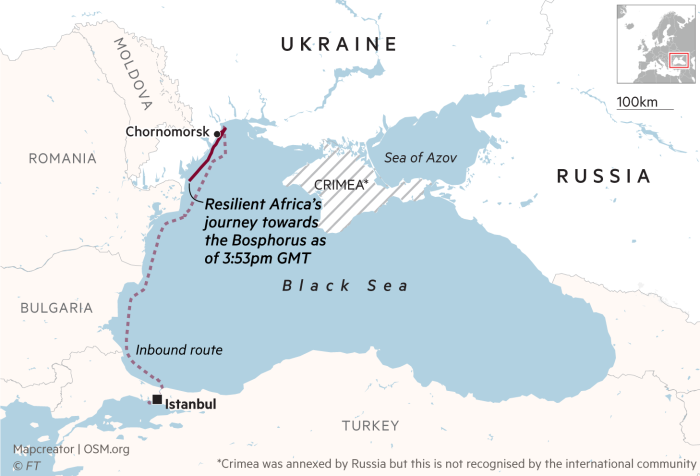Receive free War in Ukraine updates
We’ll send you a myFT Daily Digest email rounding up the latest War in Ukraine news every morning.
A cargo ship left a Ukrainian port near Odesa on Tuesday carrying 3,000 tonnes of wheat bound for international markets, despite Russia’s ongoing blockade in the Black Sea.
The vessel is one of two Palau-flagged ships that had arrived in Chornomorsk at the weekend, two months after Moscow pulled out of a UN- and Turkey-brokered agreement allowing grain exports to leave Ukrainian ports via the Bosphorus.
“The vessel Resilient Africa with 3,000 tonnes of wheat has left the port of Chornomorsk and is heading towards the Bosphorus,” said Ukraine’s deputy prime minister Oleksandr Kubrakov. He added that the second ship, Aroyat, was “in the port loaded with Ukrainian wheat for Egypt” and that the crews of both vessels were from Turkey, Azerbaijan, Egypt and Ukraine.
Moscow’s attempts to choke grain and other food exports from Ukraine, a top global supplier, have shaken markets and increased prices for the developing world. Ukraine currently exports most via EU countries by truck and rail or along the Danube river, but these routes involve added costs, hurt competitiveness and amount to a small share of prewar shipments.
Chicago wheat futures dipped more than 1 per cent on Tuesday.
Marine Traffic, an online tracking site, showed Resilient Africa travelling on Tuesday afternoon along Ukraine’s coast towards the Bosphorus. It is scheduled to dock in Israel in one week.

That route had been tested in recent weeks by five other cargo ships that had been stuck in Ukrainian ports since Russia launched its full-scale invasion of Ukraine last year. After Moscow pulled out of the grain deal, Kyiv encouraged shipping lines to use what it described as a safe corridor within range of its coastal artillery and hugging the coasts of Romania and Bulgaria, both Nato members.
Resilient Africa and Aroyat are the first to test the route both ways, docking in Ukraine, loading up on grain and leaving again via the Bosphorus.
Russia did not immediately react to the ship’s departure.
Ukraine has also redirected some of its exports via the Danube river, though that route is slower and more expensive and Ukrainian ports and grain silos in the region have come under fire from Russian air strikes in recent weeks.
Kyiv-based investment bank Dragon Capital said the alternative route had led to a 20 per cent increase in food and agriculture sales in August compared to the previous month. But sales were still 18 per cent lower than in August 2022.
Ukrainian air strikes in past weeks have increasingly targeted Russia’s navy based in Crimea, the peninsula that it illegally occupied in 2014.
Neutralising Moscow’s use of the peninsula as a military staging area is a key to breaking the Black Sea blockade and boosting Ukraine’s ongoing counteroffensive to recapture the occupied territory.
On Tuesday, Kyiv also introduced new grain export controls as it seeks to appease Hungary, Poland and Slovakia, which last week extended their ban on Ukrainian grain, claiming that it overflooded their markets and priced out local farmers.
“Such control will help prevent any market distortions in neighbouring EU member states,” said Denys Shmyhal, Ukraine’s prime minister.


Comments are closed, but trackbacks and pingbacks are open.